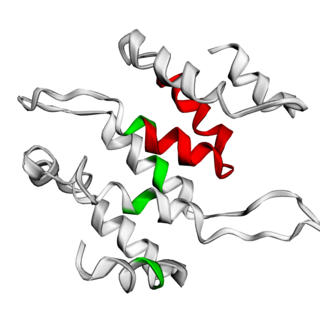
Receptor expression-enhancing protein 5 is a protein that in humans is encoded by the REEP5 gene. Receptor Expression Enhancing Protein is a protein encoded for in Humans by the REEP5 gene.

Ankyrin repeat domain-containing protein 24 is a protein in humans that is coded for by the ANKRD24 gene. The gene is also known as KIAA1981. The protein's function in humans is currently unknown. ANKRD24 is in the protein family that contains ankyrin-repeat domains.
TMEM156 is a gene that encodes the transmembrane protein 156 (TMEM156) in Homo sapiens. It has the clone name of FLJ23235.

Leucine rich repeat containing 24 is a protein that, in humans, is encoded by the LRRC24 gene. The protein is represented by the official symbol LRRC24, and is alternatively known as LRRC14OS. The function of LRRC24 is currently unknown. It is a member of the leucine-rich repeat (LRR) superfamily of proteins.

Zinc finger protein 684 is a protein that in humans is encoded by the ZNF684 gene.

PRR29 is a protein encoded by the PRR29 gene located in humans on chromosome 17 at 17q23.
Coiled-coil domain containing protein 180 (CCDC180) is a protein that in humans is encoded by the CCDC180 gene. This protein is known to localize to the nucleus and is thought to be involved in regulation of transcription as are many proteins containing coiled-coil domains. As it is expressed most highly in the testes and is regulated by SRY and SOX transcription factors, it could be involved in sex determination.

Retrotransposon Gag Like 6 is a protein encoded by the RTL6 gene in humans. RTL6 is a member of the Mart family of genes, which are related to Sushi-like retrotransposons and were derived from fish and amphibians. The RTL6 protein is localized to the nucleus and has a predicted leucine zipper motif that is known to bind nucleic acids in similar proteins, such as LDOC1.

Uncharacterized protein C2orf73 is a protein that in humans is encoded by the C2orf73 gene. The protein is predicted to be localized to the nucleus.

CRACD-like protein. previously known as KIAA1211L is a protein that in humans is encoded by the CRACDL gene. It is highly expressed in the cerebral cortex of the brain. Furthermore, it is localized to the microtubules and the centrosomes and is subcellularly located in the nucleus. Finally, CRACDL is associated with certain mental disorders and various cancers.

Transmembrane and coiled-coil domains 4, TMCO4, is a protein in humans that is encoded by the TMCO4 gene. Currently, its function is not well defined. It is transmembrane protein that is predicted to cross the endoplasmic reticulum membrane three times. TMCO4 interacts with other proteins known to play a role in cancer development, hinting at a possible role in the disease of cancer.

Uncharacterized protein C16orf86 is a protein in humans that is encoded by the C16orf86 gene. It is mostly made of alpha helices and it is expressed in the testes, but also in other tissues such as the kidney, colon, brain, fat, spleen, and liver. For the function of C16orf86, it is not well understood, however it could be a transcription factor in the nucleus that regulates G0/G1 in the cell cycle for tissues such as the kidney, brain, and skeletal muscles as mentioned in the DNA microarray data below in the gene level regulation section.
FAM71E2, also known as Family With Sequence Similarity 71 Member E2, is a protein that, in humans, is encoded by the FAM71E2 gene. Aliases include C19orf16, Protein FAM71E2, Chromosome 19 open reading frame 16, and Putative Protein FAM71E2. The gene is primarily conserved in mammals, but it is also conserved in two reptile species.

c7orf26 is a gene in humans that encodes a protein known as c7orf26. Based on properties of c7orf26 and its conservation over a long period of time, its suggested function is targeted for the cytoplasm and it is predicted to play a role in regulating transcription.

Tubulin epsilon and delta complex 2 (TEDC2), also known as Chromosome 16 open reading frame 59 (C16orf59), is a protein that in humans is encoded by the TEDC2 gene. Its NCBI accession number is NP_079384.2.

Chromosome 1 Opening Reading Frame 94 or C1orf94 is a protein in human coded by the C1orf94 gene. The function of this protein is still poorly understood.

ProteinFAM89A is a protein which in humans is encoded by the FAM89A gene. It is also known as chromosome 1 open reading frame 153 (C1orf153). Highest FAM89A gene expression is observed in the placenta and adipose tissue. Though its function is largely unknown, FAM89A is found to be differentially expressed in response to interleukin exposure, and it is implicated in immune responses pathways and various pathologies such as atherosclerosis and glioma cell expression.

Chromosome 5 open reading frame 22 (c5orf22) is a protein-coding gene of poorly characterized function in Homo sapiens. The primary alias is unknown protein family 0489 (UPF0489).

NADP-dependent oxidoreductase domain-containing protein 1 is a protein that in humans is encoded by the NOXRED1 gene. An alias of this gene is Chromosome 14 Open Reading Frame 148 (c14orf148). This gene is located on chromosome 14, at 14q24.3. NOXRED1 is predicted to be involved in pyrroline-5-carboxylate reductase activity as part of the L-proline biosynthetic pathway. It is expressed in a wide variety of tissues at a relatively low level, including the testes, thyroid, skin, small intestine, brain, kidney, colon, and more.

Zinc Finger Protein 62, also known as "ZNF62," "ZNF755," or "ZET," is a protein that in humans is encoded by the ZFP62 gene. ZFP62 is part of the C2H2 Zinc Finger family of genes.


















